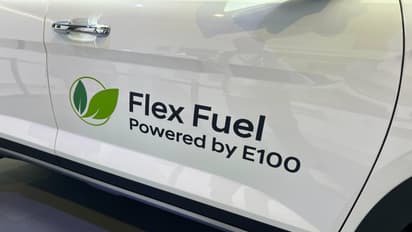Future of Clean Mobility: Will Flex Fuel Vehicles Run on Indian Roads?

Synopsis
Flex Fuel Vehicles, capable of running on a blend of petrol and ethanol, are emerging as a viable alternative. India is progressing rapidly in ethanol blending, targeting 30% by 2030, exceeding its earlier 20% goal.
(Cover image for representational purposes only)
By Ratan Mani Lal: India’s rapid economic growth has driven rising incomes, increased consumption, and an ever-growing energy demand. Fuel consumption is soaring, with road transport accounting for 87% of passenger movement and 68% of freight. According to NITI Aayog, by 2030, India’s vehicle population will reach 309 lakh two-wheelers and 41 lakh four-wheelers, with gasoline demand estimated at 5,785 crore litres. Given that road transport contributes 12% of India’s total emissions, cleaner mobility solutions are imperative to achieving the nation’s net-zero goal by 2070.
Electric Vehicles have gained significant traction, with ambitious targets set by the government. NITI Aayog aims for 30% EV penetration in private cars and 80% in two-wheelers by 2030. The Economic Survey of India 2023 projects a 49% annual growth rate in the EV sector from 2022 to 2030.
However, the EV revolution has hurdles. India’s electricity grid still relies heavily on coal, making EVs indirectly contribute to emissions. Mining battery minerals has environmental consequences, and India’s EV supply chain remains largely dependent on China. Furthermore, inadequate charging infrastructure and the high cost of electric motors deter widespread adoption. Battery recycling infrastructure is another major gap, raising concerns about sustainability.
Flex Fuel Vehicles, capable of running on a blend of petrol and ethanol, are emerging as a viable alternative. India is progressing rapidly in ethanol blending, targeting 30% by 2030, exceeding its earlier 20% goal. The government plans to introduce Ethanol 100 fuel at 400 outlets by April, while E20 fuel is already available at 12,000 outlets, with a nationwide rollout expected by 2025.
Also read: Electric vehicles to get expensive in Maharashtra? Will Hyundai, Kia, BYD be impacted?
Automakers are responding enthusiastically. Toyota launched an ethanol-powered Innova, while Maruti Suzuki introduced a Wagon R variant that supports E20 to E85 blends. Other manufacturers like Tata, Mahindra, and Hyundai also invest in FFV technology.
The biggest hurdle for FFVs is consumer confidence. While the initial cost may be slightly higher than that of conventional petrol vehicles, it is significantly lower than that of EVs. The real challenge is a classic chicken-and-egg scenario—oil companies want more FFVs on the road, while automakers seek greater ethanol pump availability.
EVs and FFVs have unique advantages, and India needs a mix of both to achieve its decarbonization goals. Recognizing this, Union Minister Nitin Gadkari has urged states to align taxes on FFVs with those on EVs, potentially reducing the initial cost gap. Such policy moves could encourage faster adoption.
Ultimately, consumers now have cleaner mobility choices. Whether India’s roads see more EVs or FFVs, the key is transitioning away from traditional fossil fuels. If consumers opt for sustainable alternatives, India will stay on track toward a greener future.
(The author is a veteran journalist, political commentator and expert speaker)
Stay updated with the Breaking News Today and Latest News from across India and around the world. Get real-time updates, in-depth analysis, and comprehensive coverage of India News, World News, Indian Defence News, Kerala News, and Karnataka News. From politics to current affairs, follow every major story as it unfolds. Get real-time updates from IMD on major cities weather forecasts, including Rain alerts, Cyclone warnings, and temperature trends. Download the Asianet News Official App from the Android Play Store and iPhone App Store for accurate and timely news updates anytime, anywhere.